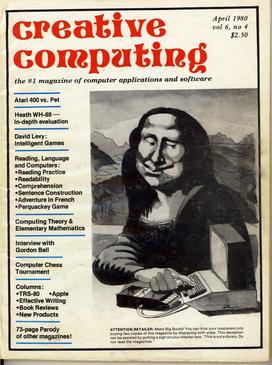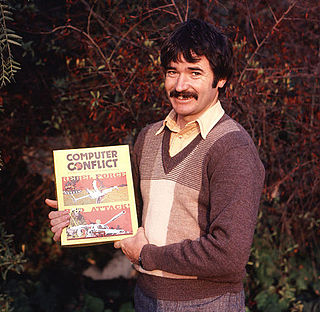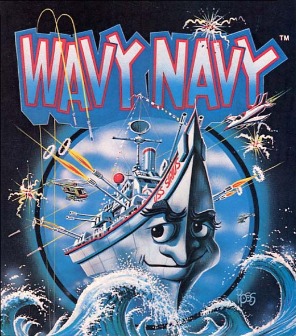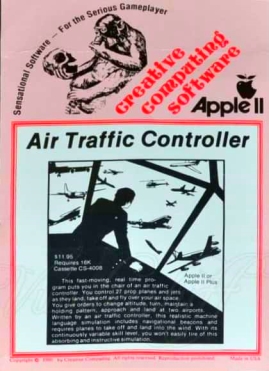| Global War | |
|---|---|
 | |
| Publisher(s) | Muse Software |
| Designer(s) | Alan M. Boyd [1] |
| Platform(s) | Apple II |
| Release | 1979 |
Global War is a 1979 video game published by Muse Software for the Apple II. It was written in Applesoft BASIC by Alan M. Boyd. [1]
| Global War | |
|---|---|
 | |
| Publisher(s) | Muse Software |
| Designer(s) | Alan M. Boyd [1] |
| Platform(s) | Apple II |
| Release | 1979 |
Global War is a 1979 video game published by Muse Software for the Apple II. It was written in Applesoft BASIC by Alan M. Boyd. [1]
Global War is a game involving the production of armies, [2] and is a clone of the tabletop board game Risk. [3]
Alan Isabelle reviewed Global War in The Space Gamer No. 34. [2] Isabelle commented that "The game has attractive features, but is not worth [the price]." [2]

Asteroids is a space-themed multidirectional shooter arcade video game designed by Lyle Rains and Ed Logg released in November 1979 by Atari, Inc. The player controls a single spaceship in an asteroid field which is periodically traversed by flying saucers. The object of the game is to shoot and destroy the asteroids and saucers, while not colliding with either, or being hit by the saucers' counter-fire. The game becomes harder as the number of asteroids increases.

Zaxxon is an isometric shooter arcade video game, developed and released by Sega in 1982, in which the player pilots a ship through heavily defended space fortresses. Japanese electronics company Ikegami Tsushinki is also credited for having worked on the development of the game.

Alfonso John Romero is an American director, designer, programmer and developer in the video game industry. He is a co-founder of id Software and designed their early games, including Wolfenstein 3D (1992), Doom (1993), Doom II (1994), Hexen (1995) and Quake (1996). His designs and development tools, along with programming techniques developed by id Software's lead programmer, John Carmack, popularized the first-person shooter (FPS) genre. Romero is also credited with coining the FPS multiplayer term "deathmatch".

RobotWar is a programming game written by Silas Warner. This game, along with the companion program RobotWrite, was originally developed in the TUTOR programming language on the PLATO system in the 1970s. Later the game was commercialized and adapted for the Apple II series of computers and published by Muse Software in 1981. The premise is that in the distant future of 2002, war was declared hazardous to human health, and now countries settled their differences in a battle arena full of combat robots. As the manual states, "The task set before you is: to program a robot, that no other robot can destroy!"

Miner 2049er is a platform game developed for the Atari 8-bit family of home computers by Bill Hogue and released by his company, Big Five Software, in 1982. The player controls Bounty Bob through multiple levels of a mine, with the goal of traversing all of the platforms while avoiding or defeating enemy mutants. At a time when "climbing games" such as Donkey Kong had four screens, Miner 2049er had ten.

Creative Computing was one of the earliest magazines covering the microcomputer revolution. Published from October 1974 until December 1985, the magazine covered the spectrum of hobbyist/home/personal computing in a more accessible format than the rather technically oriented Byte.

Rescue at Rigel is a 1980 science fiction role-playing video game written and published by Automated Simulations. It is based on a modified version of their Temple of Apshai game engine, which was used for most of their releases in this era. The game was released for the Apple II, IBM PC, TRS-80, Commodore PET, VIC-20, and Atari 8-bit family.
Sirius Software was a California-based publisher of video games for the Apple II, Atari 8-bit family, Commodore 64, and VIC-20. Most games were written for the Apple II, then ported to other systems. The company was founded in 1980 by Jerry Jewell and Terry Bradley and released over 160 games before folding in 1984. Sirius also developed games for the Atari 2600 which were published in 1982 and 1983 by 20th Century Fox Video Games. Fox's failure to pay Sirius resulted in company's downfall. Nasir Gebelli wrote some of the early hits from Sirius, establishing his reputation as an Apple II game programmer.
Nasir Gebelli is an Iranian-American programmer and video game designer usually credited in his games as simply Nasir. Gebelli wrote Apple II games for Sirius Software, created his own company Gebelli Software, and worked for Squaresoft. He became known in the early 1980s for producing fast action games for the Apple II, including 3D shooters.
In video games, first person is any graphical perspective rendered from the viewpoint of the player's character, or a viewpoint from the cockpit or front seat of a vehicle driven by the character. The most popular type of first-person video game today is the first-person shooter (FPS), in which the graphical perspective is an integral component of the gameplay. Many other genres incorporate first-person perspectives, including other types of shooter games, adventure games, amateur flight simulations, racing games, role-playing video games, and vehicle simulations.

Roger Keating is an Australian computer game designer. Along with Ian Trout, Keating co-founded of the video game company Strategic Studies Group, which is known for its strategic war and fantasy games with artificial intelligence. Keating and Trout worked together on the majority of SSG titles.

Beneath Apple Manor is a roguelike game written by Don Worth for the Apple II and published by The Software Factory in 1978. Higher resolution "Special Editions" were released in 1982 and 1983, through Quality Software, for the Apple II and Atari 8-bit family. It was one of the first video games to use procedural generation.

Wavy Navy is a video game designed by Rodney McAuley for the Apple II and published by Sirius Software in 1983. Atari 8-bit family and Commodore 64 versions were released the same year. Wavy Navy is a nautically themed fixed shooter with left and right controls to move the player's PT boat, but there is an additional vertical element as the boat moves up and down with the large ocean waves that scroll beneath it. The direction and speed of the waves vary per level. Some reviewers found that the movement of the waves added an interesting twist, while others called it too similar to other fixed shooters like Galaxian.

Bill Budge's Space Album is a collection of four Apple II action games written by Bill Budge and published by California Pacific in 1980. The games are Death Star, Asteroids, Tail Gunner, and Solar Shootout. Death Star was based around a scenario similar to the Death Star "trench battle" that formed the climax of the 1977 film, Star Wars Episode IV: A New Hope. Asteroids was a variant of the popular arcade video game of the same title.

Air Traffic Controller is a 1978 video game written by air traffic controller David Mannering, and released by Creative Computing for the TRS-80 Model I and Exidy Sorcerer in 1978, and for the Apple II, Apple II Plus and Sol-20 in 1979. It was later rewritten by Will Fastie and Bill Appelbaum for Data General AOS in 1980, and ported to DOS for release by PC Disk Magazine in 1983.

Deathmaze 5000 is TRS-80 computer game written by Frank Corr, Jr. and published by Med Systems Software in 1980. It was ported to the Apple II and followed by the second game in the Continuum series, Labyrinth.

Empire of the Over-Mind is an interactive fiction game written by Gary Bedrosian and published by Avalon Hill for the Apple II, Atari 8-bit, and TRS-80 in 1981. A version with an enhanced display for DOS by Bedrosian was published in 1986.

Stone of Sisyphys is a 1981 video game developed by Chameleon Software for the Apple II, Atari 8-bit family, and TRS-80, and published by Adventure International.

War in Russia is a 1984 computer wargame developed and published by Strategic Simulations for the Apple II and Atari 8-bit family. It was designed by Gary Grigsby.

NukeWar is a 1980 video game by Avalon Hill for the Apple II, Atari 8-bit family, Commodore 64, Commodore PET, FM-7, TRS-80, and VIC-20.